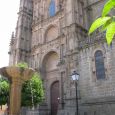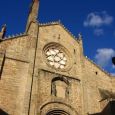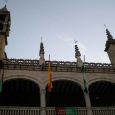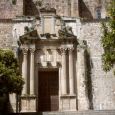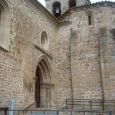Plasencia
Advertisement
By railway
Plasencia has a railway station on Avenue Ambroz. The railway linking it to Madrid via Talavera de la Reina and Seville via Caceres. Until the mid 1980's was in service line that bound to Salamanca, which is currently disused but is considering its reopening, as the stretch Plasencia-Salamanca is the only closed from Gijon to Seville .The project is in the process of high-speed line linking Madrid with Lisbon and that will have a station in the city, probably in the area known as Fuentiduena.
By bus
The Bus Station is situated on the street Tornavacas, Plasencia regularly joining with other cities in Spain, as well as nearby towns.Within the province of Caceres, the company Mirat has several lines to connect Plasencia with the different regions of the northern half of the province and even in Madrid through Alcorcon and Mostoles. Another company whose lines pass through Plasencia is CEVESA, which has a long distance line connecting Plasencia with Avila and Madrid via the Jerte Valley.
By road
E-803,A-66 - Highway Route de la Plata - Communicates with the north and south of the province ( Ambroz Valley ) and the Peninsula.EX-A1 - Extremadura Motorway North - Communicates with the east of the Peninsula ( Navalmoral de la Mata, Madrid.) and to the west of the province and Portugal .N-630 - National Highway N-630 - Communicates with the north and south of the peninsula runs in parallel with the A-66, so is rarely used.N-110 - National Highway N-110 - It communicates with the Jerte Valley and Avila.EX-108 - Navalmoral de la Mata to Portugal for Moral - Communicates with the west of the province to Monforte ( Portugal ), for Moral
Old Cathedral of Plasencia
The Old Cathedral of Plasencia, transitional style from Romanesque to Gothic, has a cover on the outside Romanesque arch with archivolts. Construction began in the thirteenth century and was enlarged in the fifteenth century. It has three naves and four bays with vault, the work of Gil de Cisler. In his inspired rectangular cloister Cistercian can see the image of Santa María la Blanca XII century, in Gothic style.Accessed from the cloister to the chapel of St. Paul (formerly of the Cathedral Chapter House, attributed to Gil CISL), the Romanesque-Gothic style with Byzantine and Oriental influences, whose dome is usually included in the so-called Leon domes group together with those of the Old Cathedral of Salamanca, the Cathedral of Zamora and Toro Collegiate .
New Cathedral of Plasencia
The New Cathedral of Plasencia is located in the city of Piacenza, in northern Extremadura and OBIP is the seat of the same name. Temple is the largest and richest ornamentation of Extremadura .Construction began in the year 1498 and ended in 1578, in which the works were a standstill. Later they were taken up during the eighteenth century, finally being unfinished.
Church of the Savior
The Church of the Savior is a temple of the city of Plasencia. Style mostly Romanesque and has addictions Gothic Gothic later. In the eighteenth century the church suffered the collapse of its roof, thus being restored later. It gives name to the square where stands one of the shutters and the wall, given its proximity.
Church of St. Stephen
The Church of St. Stephen in Piacenza is situated very close to the Plaza Mayor and the square is named (Ricon of San Esteban ) which has its main entrance in front. This church dates from the fifteenth century, with its apse of Gothic style. Its main altarpiece is Plateresque transition to the Baroque. It married the famous poet José María Gabriel y Galan, a fact which is commemorated with a plaque of Talavera tiles. Faced with one of its doors is called Corral of Mayors.
Church of San Pedro
The Church of San Pedro is one of the oldest temples in Plasencia and also one of the least modifications have suffered throughout history. It is located next to the wall Placentines Street in San Pedro, the same name. You have reason Roman on the cover and in the apse, and there among them a curious style window blinds Moorish Toledo.
Church of St. Martin
The Church of San Martin is consideradada as the oldest parish in the city of Plasencia. It is a temple built in the XIII century, the interior has three naves and keeps a gold and polychrome altarpiece paintings Luis de Morales, nicknamed the Divine, dated 1570. At present no cult. Belongs Caja de Extremadura and is used as an exhibition, especially the Salon d'Automne organized entity.
Church of Santo Domingo
The Church of Santo Domingo is located in the city of Plasencia and attached to the Convent of Santo Domingo which included until the convent ceased to perform the functions as such.The church of the convent follows the route of a Latin cross with side chapels in the nave. These shrines served as a mausoleum for the noble families Piacenza. The top is domed shaped, with different architectural solutions for each segment. Being the most common of straight and curved ribs that are crossing. It has a very remarkable Mannerist altarpiece dating from the sixteenth century. Also noteworthy Talavera tile altar that is in the sacristy and is attributed to Juan de Flores.
Palacio Municipal
The Palacio Municipal de Plasencia is located in the Plaza Mayor. The present building is a reconstruction conducted nerohistoricista the aquitecto José Manuel Gonzalez Valcarcel in 1966 relying on style building in the Renaissance that projected Juan de alava in 1523, the aldermen who demanded to be done with portals and runners. It has therefore a double arch with the coat of Carlos I of Spain in one of its piers. On the other there is a bell tower where you can watch the most famous and beloved city: Grandpa Mayorga, who is in charge of the times the population. Inside you can admire the door of the chapel and the Archive in 1569, and the inscription commemorating the Taking of Granada by Ferdinand and Isabella, which was located on Talavera's Gate to the destruction of it.
March - June


